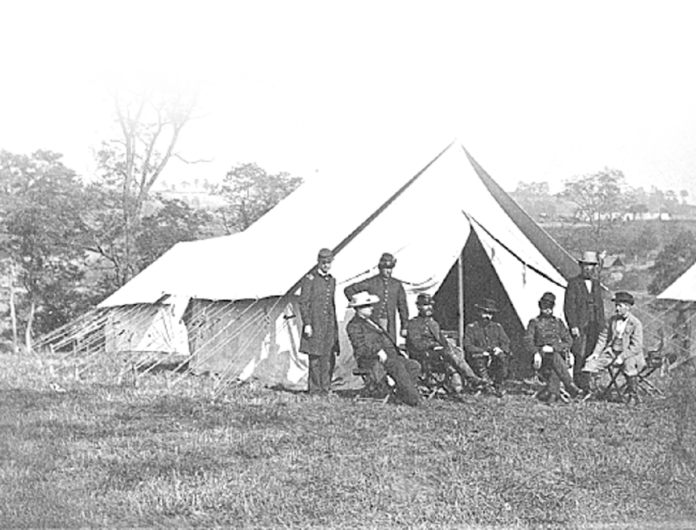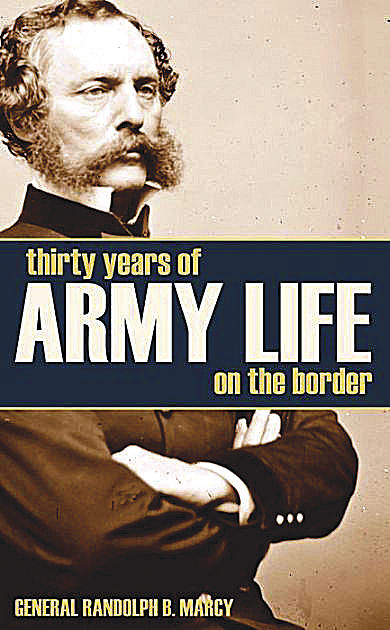BY NORMAN ROZEFF
The Lower Rio Grande Valley has experienced a number of important military figures, including Zachary Taylor, Robert E. Lee, Ulysses S. Grant, and Phil Sheridan. Very much less known is Randolph Barnes Marcy, who played an important role in the early U. S. west.
He was born in April 1812 in Greenwich, Massachusetts. As a 16-year-old he began his military career at the United State Military Academy at West Point where he was graduated 29th in the class of 1832.
He became an officer of the Fifth Infantry and reached the rank of captain by May 1846. Much of his early military career was spent on the northwest frontiers of Michigan and Wisconsin.
It was at the Battle of Palo Alto on May 8, 1846, that Marcy found himself right in the thick of things as the Fifth Infantry on the right faced Mexican General Torreon’s Cavalry charge. Col. David E. Twigg with Lt. Col. James S. McIntosh’s 5th Infantry and Maj. Samuel Ringgold’s artillery battery slowed the Mexican action enough allowing Twiggs to form the 5th Infantry into a square to meet them with a couple of volleys.
Later, the badly beaten Mexican army retreated from this field of action. Marcy must have handled himself well, for, by May 18 he was promoted to captain.
Marcy would again see action the following day, May 9, at the Battle of Resaca de Palmas. The Fifth Infantry would secure the heavy guns left behind by General Arita’s retreating Mexican forces.
Detached for recruiting duties, Marcy would return to Texas in 1847. The federal government needed to accurately map the new area secured after the signing of the Treaty of Guadalupe Hidalgo officially ending the war. So it was that in 1849 Marcy returned again to the southwest and determined the route of the Marcy Trail, from Fort Smith (now Arkansas) to Santa Fe. Two years later he commanded the escort to Gen. General William Belnap’s tour that selected the sites for forts on the Texas frontier.
“In March 1852 Marcy was assigned the command of a seventy-man exploring expedition across the Great Plains in search of the source of the Red River and directed to ‘collect and report everything that may be useful or interesting.’”
Second in command of the Marcy expedition was Capt. George B. McClellan, who would one day become his son-in-law and later still his commander during the Civil War.
Marcy’s expedition “crossed a thousand miles of previously undocumented Texas and Oklahoma territory, discovering numerous valuable mineral deposits as well as twenty-five new species of mammals and ten of reptiles. He reportedly discovered the sources of both forks of the Red River, as well as the Palo Duro and Tule canyons, which he became the first white man to explore.
“The expedition encountered and documented the little-known Wichita Indians and compiled the first Wichita dictionary. It also returned with information on Cynthia Ann Parker.”
Marcy tidied up his findings in a highly circulated report titled “Exploration of the Red River of Louisiana, In the Year 1852…With Reports on the Natural History of the Country,” supplemented by a handsome collection of lithographs. Published in 1853, it quickly became a classic of Western Americana.
Marcy’s explorations of the West weren’t over. The Handbook of Texas Online notes the following:
“In 1854 Marcy surveyed Indian reservations in northern and western Texas, and in 1856 he explored the headwaters of the Big Wichita and Brazos rivers. His report of the 1856 expedition was published by the United States Senate.
“In 1857 he served briefly against the Seminole Indians in Florida and accompanied Gen. Albert Sidney Johnson’s expedition against the Mormons later that year. During that campaign he received national fame for a winter march of over a thousand miles to secure relief for Johnston’s army, which was stranded without supples in the Utah mountains.
“After this adventure Marcy was recalled to Washington to prepare a semiofficial guidebook for the War Department. The result, The Prairie Traveler (1859), was an excellent compendium of such practical hints for travelers about what equipment to carry, methods of organizing a wagon train, and techniques of avoiding Indian attacks, as well as detailed notes on thirty-four of the most important overland trails. On August 22, 1859, Marcy was promoted to major and assigned as regimental paymaster.”
Marcy would continue to serve his country and receive promotions during the Civil War. He served as inspector general of the U.S. Army from September 25, 1861 to January 2, 1881. Marcy’s The Prairie Traveler: a handbook for overland expeditions has been reprinted many times and contains wonderful illustrations along with its practical camping advice.






